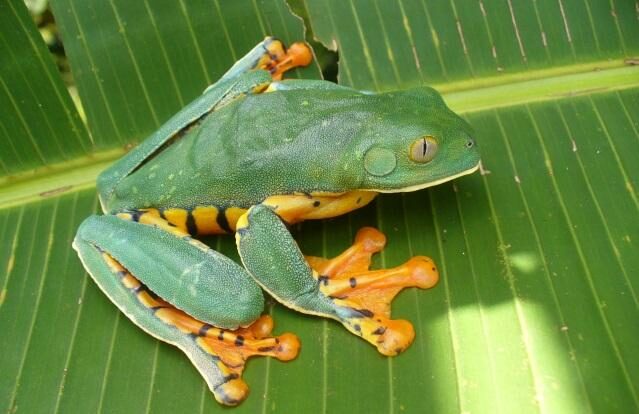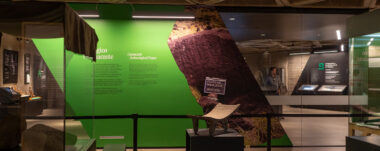Costa Rica: The Small Country with Exuberant Biodiversity

Cruziohyla sylviae
Costa Rica is a Central American country bordered to the north by Nicaragua and to the south by Panama, which maintains 4% of the planet’s biodiversity in a territory that barely represents 0.03% of the terrestrial geoid. To show such natural richness this note focuses mainly on wildlife with emphasis on fauna.
SOME EXAMPLES THAT ILLUSTRATE THE RICH BIODIVERSITY IN THE CONTINENTAL TERRITORY OF COSTA RICA ARE:
BUTTERFLIES
Recently with the use of DNA it is estimated that there are in the country more than 4000 species of diurnal butterflies and more than 16,000 species of nocturnal butterflies, which would be more than 20,000 species. This amount is equivalent to 60% of the number of species belonging to the entire African continent, which has a total area of over 30,000,000 km ², ie Costa Rica fits more than 590 times within the territory of Africa.
BIRDS
In relation to the avian fauna, there are 923 species of birds in Costa Rica. This is a higher number than the amount of bird species found in North America in the territories of Canada and the United States, which together total 19,581,630 km², i.e. Costa Rica fits 383 times in the same area.
It is worth noting that only in the La Selva Biological Station, which has an area of about 16 km² and is located in the area of Sarapiqui in the province of Heredia, there are about 500 bird species..
TREES
In the case of trees in temperate countries there are about 20 species of trees per hectare while in Costa Rica we often find more than 200 species of trees per hectare. These are just some examples to illustrate the richness of species that Costa Rica has.
WILDLIFE SPECIES TO BE FOUND IN COSTA RICA
AMPHIBIANS
In regards to amphibians there are 216 species, among which are the poison dart frogs Oophaga pumilio, Oophaga granulifera, as well as Dendrobates auratus, the red-eyed tree frogs Agalychnis callidryas, glass frogs such as Hyalinobatrachium fleischmanni which is one of the most abundant, as well as the bell frog Disphorus distema, the clown frog Dendropsophus ebraccatus, the masked tree frog Smilisca phaeota and the common toad Rhinella marina.
REPTILES
In the case of reptiles, the country has 265 species, among the most common species are the Garrobos Ctenosaura similis, the green iguanas Iguana iguana, the lizards Jesus Christ Basiliscus plumifrons, Crocodiles Crocodylus acutus and Caiman Caiman crocodilus, the Boa or Bécquer Boa imperator, six of the eight existing species of sea turtles, among which are the leatherback turtle Dermochelys coriacea, the hawksbill turtle Eretmochelys imbricata, the olive ridley turtle Lepidochelys olivacea, the green turtle Chelonia mydas among others.
THE OUTSTANDING CASE OF THE MASSIVE ARRIVALS OF SEA TURTLES
On the north pacific coast of our country, specifically Santa Cruz in the province of Guanacaste, there is a very particular site such as the National Wildlife Refuge Ostional, a site where the phenomenon known as massive arrivals of the Olive Ridley Turtle Lepidochelys olivacea occurs, although throughout the year there are massive arrivals, it is known that the largest arrivals occur in the rainy season in the months of September, October and November.
In a single moment in the 7 km of beach, more than 250,000 olive ridley turtles have been counted, it is a very interesting, emotional and beautiful phenomenon or biological event to observe.
BIRDS
Among its 923 species, some very iconic species such as the Quetzal Pharomachrus mocinno, the Bellbird Procnias tricarunculata, the more than 50 species of hummingbirds such as the Fire-throated Hummingbird Panterpe insignis and the Selasphorus genus sparks, the Toledo Chiroxiphia linearis, the 6 species of toucans such as the Rainbill Ramphastos ambiguus, the Umbrella Bird Cephalopterus glabricollis, the Red Macaws Ara macao, the Green Macaws Ara ambiguus, and the Magpie Cyanocorax formosus among others.
MAMMALS
With respect to mammals there are 256 species, among the most prominent and most common we can find the Raccoon Procyon lotor, the Pizote Nasua narica, the Furry Foxes Didelphis marsupialis, Squirrels mainly of the genus Sciurus, the Coyote Canis latrans, the gray fox Urocyon cinereoargenteus.
Also the country has six species of felines such as: the largest is the Jaguar or American Tiger Panthera onca, followed by the Puma Puma concolor, in third place is the Ocelot or Ocelot Leopardus pardalis, followed by the Lion Puma yaguarondi, we also have the Caucel or Margay of arboreal habits Leopardus wiedii and the smallest of all is the Oncilla or Tigrillo Leopardus tigrinus.
In Costa Rica there are also four species of monkeys, the howler monkey Alouatta palliata, the spider monkey Ateles geoffroy, the white-faced monkey Cebus imitator and the squirrel monkey Saimiri oerstedii, the two-toed sloth Choloepus hoffmanni and the three-toed sloth Bradypus variegatus.
In Guanacaste, especially in the dry season, it is very easy to spot the White-tailed Deer Odocoileus virginianus.
MAIN REASONS FOR THE RICH BIODIVERSITY OF COSTA RICA:
- The presence of the Pacific Ocean and the Caribbean Sea
- The geographic location of 10 degrees north of the Equator (Tropic)
- The presence of several mountain ranges throughout the territory, which establishes different altitudinal levels.
- More than 1000 rivers
- More than 100 volcanoes
- The role of biological bridge that Costa Rica has played between two enormous continental masses such as North and South America.
TIPS FOR THE TRAVELER:
Now not all species are easy to observe or easy to detect for which it is required to have some minimum equipment, appropriate clothing including hiking shoes and comfortable clothes, it is always recommended the use of blockers and insect repellent, for each taxonomic group there are times, sites and times more appropriate to detect species more easily. For example for the case of birds it would be between 5 and 8 in the morning and between 3 and 5 in the afternoon, it is also easier to detect bird species on the edges of roads, on the edges of rivers and in the forest air interface that within the forest itself, although in the forest there are also many species, the small amount of light, shadows and the amount of vegetation in the understory do not make it easy to detect.
It is very important to have some of the guides or illustrated sheets, to have binoculars or binoculars that can be 10 × 40 or 10 × 42 to facilitate the observation of wildlife.
Hiring tour guides makes it much easier to move around, establish schedules, detect and identify species, and visit appropriate sites and safer areas.
Author: MSc. Jorge Hernández Benavides, Wildlife Biologist
email: [email protected]
Photo credits: Jorge Hernández Benavides
Navigate articles





